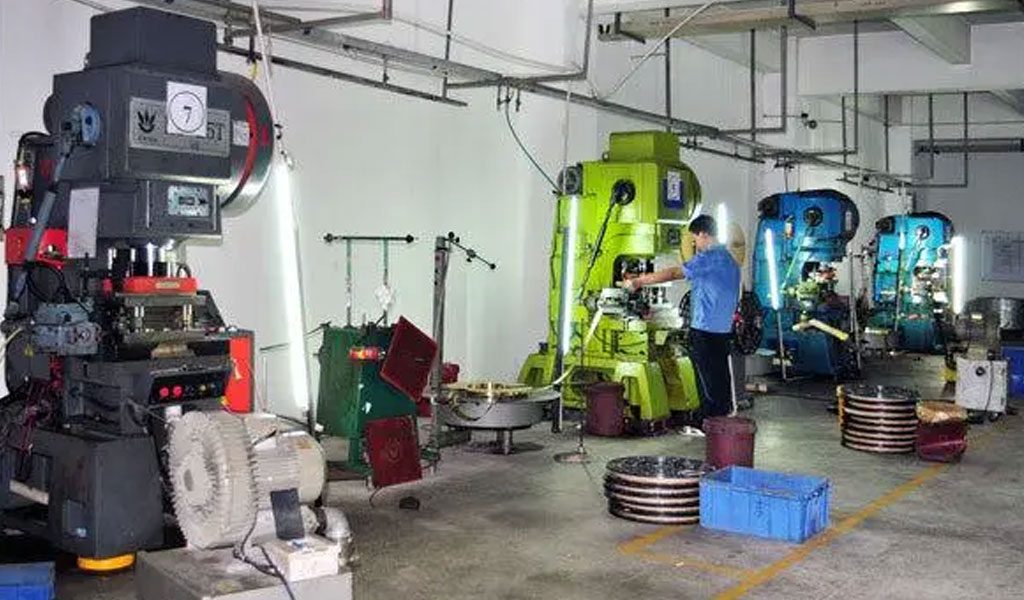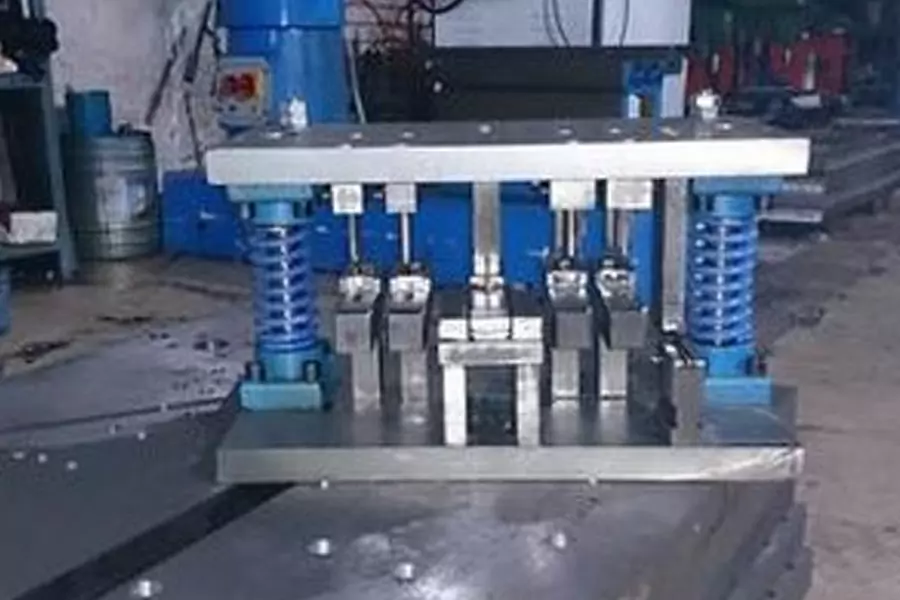
The production of automobile body mainly includes four important links: stamping, welding, painting and assembly, and about 60% of the parts of automobile panels are produced by stamping.
With the development of finite element numerical simulation technology, the use of finite element technology to simulate the stamping process of sheet metal can grasp the flow of sheet metal during the forming process, and predict the cracking, wrinkling, springback and other defects that may occur during the stamping process. By adjusting the flow speed and stress-strain relationship of the sheet material, the forming quality can be improved, the scrap rate can be reduced, and the production cycle can be shortened.
The rear wheel cover of the car is one of the common large car covers, which can play the role of protecting the car body. In this paper, based on the AutoForm finite element analysis software, the stamping simulation analysis of the rear wheel cover of the automobile is carried out, and the failure modes such as wrinkling and insufficient drawing that may occur in the forming process are predicted, and the minimum thickness of the sheet is used as an index to analyze the orthogonal test. The method optimizes the process parameters, determines the optimal combination of process parameters, and actually produces an automobile rear wheel cover with good formability.
Establishment Of The Finite Element 3D Model
In this paper, the geometric model of the car wheel cover is established by using the three-dimensional design software CATIA, and its overall size is 1555 mm × 402 mm × 570 mm, and CATIA is used to splicing or stitching the surface pieces into an overall composite surface, and save it as “*.igs”. ” format and then import it into AutoForm. The DC04 stamping steel is used for simulation, the thickness of the sheet is 1.5mm, and the properties of the material are shown in Table 1.
The rear wheel cover of the automobile has the characteristics of large structure size, thin thickness, high precision and high deep drawing. Combined with the characteristics of the parts, the process plan for producing the parts is determined as: blanking → deep drawing → trimming and punching.
In the actual production process, the forming of the rear wheel cover of an automobile requires multiple processes such as blanking, deep drawing, trimming, punching, and flanging, among which the deep drawing process has the greatest impact on the forming quality of the rear wheel cover of the automobile. Since the deep-drawn automobile rear wheel cover is prone to defects such as wrinkling, cracking and springback, and affects the subsequent forming quality, the deep-drawing forming process is the focus of this paper.

AutoForm performs adaptive mesh division on the imported car rear wheel cover, and determines that the tolerance error of the mold mesh is 0.05mm, and the maximum side length is 30mm. The basic process of AutoForm finite element numerical simulation: ① Determine the stamping mode of single-action deep drawing, and determine the stamping direction based on the principle of no stamping negative angle; ② Fill the cavity of the rear wheel cover of the automobile; ③ Use the method of adding section lines to design the pressing material ④ Design process supplement; ⑤ Expand 40mm outward along the parting line to set equivalent drawing beads; ⑥ Use the finite element algorithm based on the full increment theory to reversely solve the initial sheet size, and determine the size of the sheet to be 1980mm× 780mm. The initial position of the drawing tool is shown in Figure 1.
Test Results And Discussion
Setting of stamping process parameters
Firstly, the process parameters are selected initially, and the influence trend of each factor on the part thinning rate is studied. In the stamping process of automobile rear wheel cover, process parameters such as blank holder force, punch and die gap, friction coefficient and so on play a crucial role in the forming quality of the parts. Appropriate blank holder force can effectively ensure the smooth progress of the drawing process. In the initial simulation process, the blank holder force is selected according to the empirical formula:
F=σs×t×L
Where: σs is the material yield strength; t is the sheet thickness; L is the parting line length. The blank holder force solved by calculation is 900kN. The punch and die gap is generally selected by Z/2=(0.9~1)t (parts with high drawing accuracy requirements) and Z/2=(1~1.1)t (parts with general drawing accuracy requirements). When the gap between the convex and concave dies is too small, the drawing force and frictional force on the sheet will be large, which will easily cause the cover to break during the drawing process and affect the life of the die; when the gap between the convex and concave dies is too large, the rear wheel cover of the car Poor forming quality. Therefore, this paper selects 1 times the thickness of the sheet, 1.5mm, as the gap between the convex and concave die. The friction coefficient is generally adjusted by lubricating oil, and the friction coefficient is set to 0.17 according to the actual production and the simulation requirements of AutoForm software. The stamping speed will affect the production efficiency. Generally, the stamping speed is selected as 1000mm/s.
Influence of process parameters on forming quality
In the stamping simulation process of the rear wheel cover of the automobile, the determined process parameters were selected, and the method of controlling variables was used to study the influence of different blank holder forces, punch and die gaps, and friction coefficients on the variation of the thickness of the parts.
Figure 2 shows the influence of various factors on the maximum reduction rate of plate thickness. It can be seen from Figure 2(a) that when other conditions are the same, the thickness of the sheet gradually decreases with the increase of the blank holder force. When the blank holder force is between 700 and 1000 kN, the thickness of the rear wheel cover of the automobile does not change significantly. When the blank holder force exceeds 1000 kN, the thickness change increases sharply. It can be seen from Figure 2(b) that with the increase of the gap between the convex and concave dies, the maximum thinning of the sheet increases first and then decreases, reaching the maximum (23.20%) at 1.65mm; when the gap between the convex and concave dies exceeds 1.65mm, With the increase of the punch and die gap, the maximum thinning rate of the sheet material decreases gradually. It can be seen from Figure 2(c) that the friction coefficient has a great influence on the thickness of the sheet metal. As the friction coefficient increases, the thickness of the sheet material gradually decreases. When the friction coefficient increases to 0.21, the maximum thinning rate of the material exceeds 30%, which is prone to the risk of rupture and does not meet the requirements of the stamping process.
Orthogonal test scheme design
In the actual production process, the stamping effect of the automobile rear wheel cover does not depend on a single factor, but is determined by multiple factors. In the actual production process, the stamping effect of the automobile rear wheel cover is generally considered to be an automobile cover. The maximum thinning rate of not more than 30% is qualified.
In order to obtain the best forming effect of the automobile rear wheel cover, on the basis of studying a single process parameter, the orthogonal test method is used to scientifically arrange and analyze multiple factors to obtain the optimal process parameter combination. In this test, on the basis of studying the influence of blank holder force, friction coefficient, and gap between convex and concave die on the maximum thinning rate of the rear wheel cover, the stamping speed and the width of the drawing rib were added as test factors.
The standard orthogonal table L16 and the factor level table are shown in Table 2. In this test, the minimum thickness after the simulated stamping is used as the evaluation index, and the primary and secondary order of the five process parameters affecting the deep drawing of the rear wheel cover of the automobile is determined. The orthogonal test scheme and result analysis are shown in Table 3.
The Analysis Of Test Results
The results of the orthogonal test are subjected to range processing, K=ΣKij (i=1, 2, 3, 4; j=A, B, C, D, E); k=ΣKij (i=1, 2, 3, 4; j =
A, B, C, D, E); Rj=kmax-kmin, the range analysis of orthogonal test results is shown in Table 4. The primary and secondary order of the influence of each factor with the minimum thickness as the evaluation index: C>B>A/E>D, in which the friction coefficient has the greatest influence on the minimum thickness, and the width of the drawn bead has the least influence on the minimum thickness. The process plan is C1B3A1E2D1 (friction coefficient 0.13, stamping speed 1500mm/s, blank holder force 800kN, punch and die gap 1.35mm, drawing rib width 16mm); the above process plan is simulated by AutoForm finite element analysis software, and the minimum thickness is The optimal process scheme of the index (C1B3A1E2D1) has a maximum thinning rate of 22.56%, which is in line with the expected forming quality. By comparing the plan’s formability cloud map, forming limit map FLD, and thinning rate cloud map, the optimized forming cloud map and FLD are shown in Figure 3. Therefore, C1B3A1D1E2 is selected as the final forming plan. And the actual stamping of this scheme is obtained, as shown in Figure 4, which is caused by objective factors such as contact heat transfer before the pressure of the automobile with good formability.
It is relatively feasible to use a combination of simulation and experiment to solve the heat transfer model of the double-layer structure to water, which can solve the problem that the change of the inner tube temperature during the expansion process cannot be calculated theoretically and is inconvenient to measure. Based on the theoretical analysis and calculation of thermal hydraulic pressure based on some assumptions, the process schematic diagram of hot water pressure is formulated, which can effectively guide industrial production.
Conclusion
The method combined with the experiment is feasible to solve the problem that the change of the inner tube temperature during the expansion process cannot be calculated theoretically and is inconvenient to measure.
Sheet fabrication services for mild steel, high strength low alloy (HSLA) steel, cold/hot rolled steel, galvanized steel, stainless steel, aluminum, copper and brass. Capable of fabricating parts up to 12 ft. length and +/-0.001 in. tolerance. Various capabilities include contract manufacturing,custom stamping,edge rolling, forming,top laser cutting, roll bending and welding. Finishing and secondary services such as hardware installation, tapping, deburring, cleaning, heat treating, plating, anodizing and painting available. Sheet Metal Prototype and low to high volume production runs offered. Suitable for commercial/residential architectural, aluminum brake shape parts, wall panel systems, brackets, general flashings, rails, call button plates and ship building component parts.
